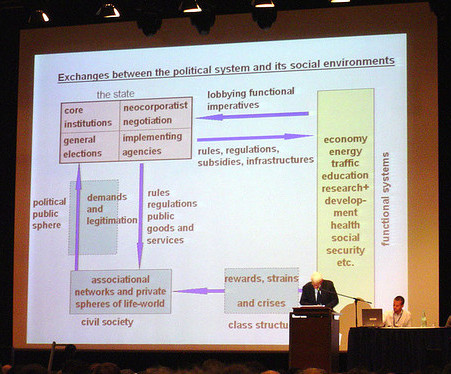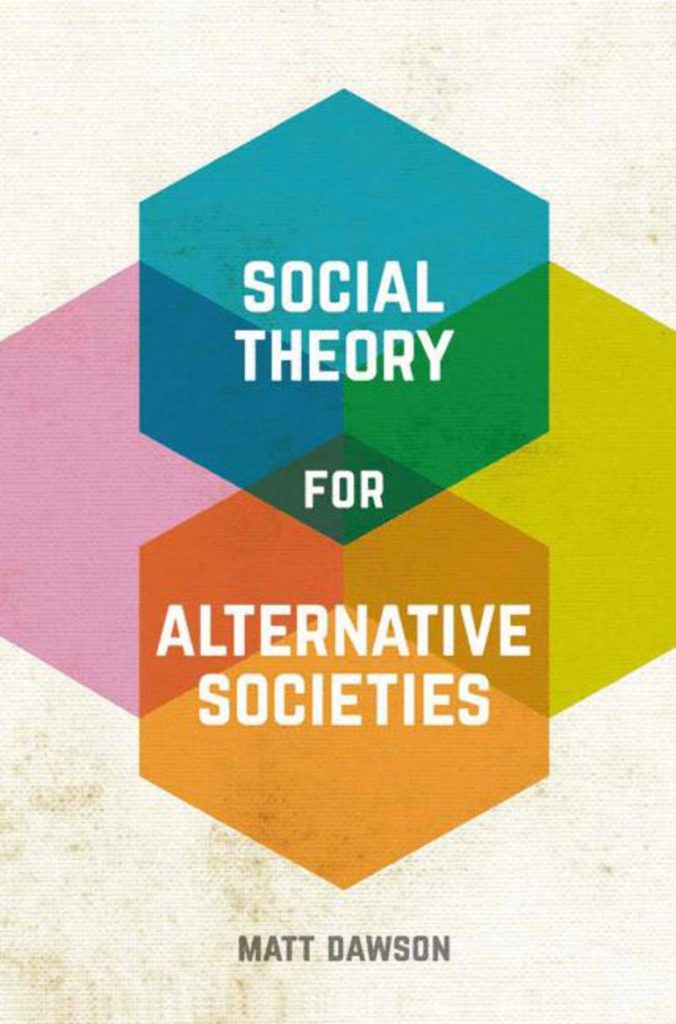(Current post follows on from this introductory post)
In the introductory section to chapter seven (p203), Habermas lays out the basic argument that he is concerned with in section I (chapter is in three parts):
The framework of his action theory proved too narrow for Parsons to develop a concept of society from that perspective; thus he felt it necessary to represent complexes of action directly as systems and to convert social theory from the conceptual primacy of action theory over to that of systems theory.
As Habermas had already pointed out (p201), giving conceptual primacy to systems theory over and above action theory appeared to go against Parsons’ own understanding. As Parsons stated himself (quoted in Habermas, p201),
the subject of social interaction is in a fundamental sense logically prior to that of the social system.
It is the question of why Parsons reversed his analysis in favour of a systems theory of society that pre-occupies Habermas in section I.
It should be pointed out first of all that each of the three parts to section one [the action-theoretical project of 1937] correspond to what Habermas views as the three most important decisions in theory construction Parsons made in his turn away from action theory towards the development of a systems theory of society. As the title of Part A suggests, the first important decision is connected to Parsons early action-theoretical project. You could say that Habermas is looking for the early conceptual weaknesses, weaknesses that are built into the foundation of Parsons’ theory and that would inevitably lead to its eventual downfall. It is in Parsons early work on action-theory that Habermas finds the first and possibly the most crucial weakness for the development of a theory of modern society, and that is, logically enough, Parsons’ concept of action, or more precisely, his monadic concept of action. I will start this reading by beginning at the end of part A, where Habermas outlines this first important decision, and from there work backwards in order to understand more clearly just how Parsons came to make this decision and what Habermas believes is wrong with it. On page 214, Habermas outlines, at one and the same time, the decision and the problem for theory construction that goes with it. I quote here at length as this paragraph essentially summarizes both the foundation for Parsons’ later work and the conceptual weaknesses that, according to Habermas, ensure the theory’s redundancy in the face of modern social pathologies:
Parsons begins with the monadic actor and seeks to establish a conceptual transition from the unit act to the nexus of action by viewing elementary interaction as made up of the actions – introduced independently, to begin with – of two actors. The point of departure for his analysis is the singular action orientation conceived of as resulting from contingent decisions between alternatives. Since the regulative force of cultural values does not negate the contingency of these decisions, every interaction between two actors entering into a relation takes place under the condition of ‘double contingency’. This is treated as a fact that generates a problem: it makes ordering accomplishments functionally necessary. In the logical construction of interaction, the double contingency of free choice by ego and alter is prior to the ordering mechanisms that coordinate actions. At the analytical level of the unit act, value standards are attributed to individual actors as something subjective; thus they need to be intersubjectively harmonized.
It should be clear that Habermas is critiquing Parsons from the vantage point of his own theory of communicative action, as this statement of Parsons’ action theory has echoes of Habermas’ earlier critique of both Weber and the Frankfurt school (earlier as in the 2 volumes of TCA). In particular, it is the last four lines of the above quote that introduce us to the bedrock of Habermas’ critique: Parsons treats intersubjectively shared values as something that is applied after the orientation to action. It is important to note that these values which function as ordering mechanisms of the actions of two individuals, cannot, according to Habermas, be somehow ‘tacked on’ after the orientation to action has taken place, in an attempt to either ensure social order or account for it theoretically (the latter being more significant for the present discussion): These values are for Habermas, always already there. As he states himself (p214),
[T]his view (Parsons) stands in contrast to the idea of a cultural system of values that is intersubjectively shared from the start.
The problem it appears is that Parsons is not just trying to establish a theoretical account of the unit act, but attempting to establish what Habermas called above ‘a conceptual transition from the unit act to the nexus of action’, i.e., a connection between the unit act and the action system. This attempt to connect unit and system is, in fact, what Habermas is referring to when he talks about a ‘normativistic theory of action’. It should be pointed out at this stage that the analysis presented in part A centres around Parsons’ attempt to explain both the unit act and the action system and how they interconnect, and in the next post I want to examine this attempt in order to better understand Habermas’ position.














